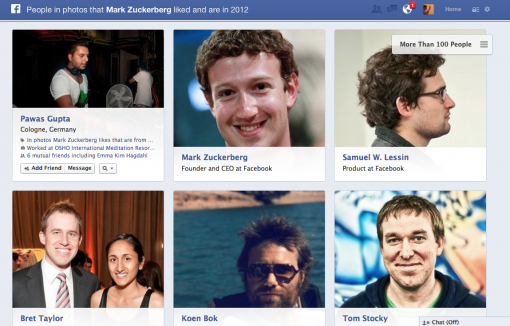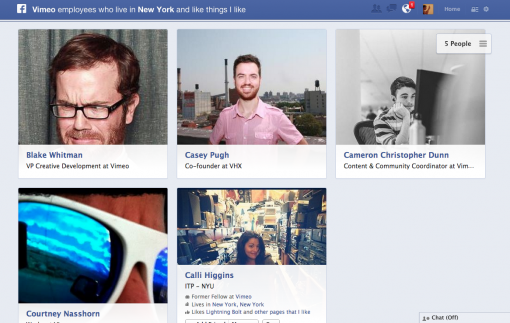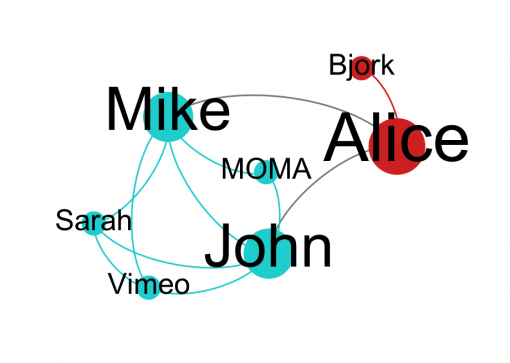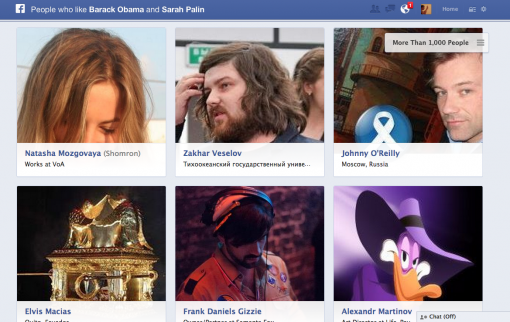Posted by Nodus Labs | January 20, 2013
Facebook Graph Search Promotes Network Thinking in a Bubble

Mark Zuckerberg is, after all, a good guy. With the new Facebook Graph Search we’ll finally be able to tap into that huge database of relations between the people, places and things.
Consider, for example, this search query below: it shows us the people in the photos that were liked by Mark Zuckerberg in 2012. He is not my Facebook friend, but that information is still available to me. Using it I can see what people he is interested in. One of the people that appears more often on the photos that Mark likes is Pawas Gupta who worked at an OSHO center in India. A quick Google search shows us that Zuckerberg did visit OSHO commune in 2010, but the Facebook Graph gives us much more specifics, and that’s great.

Facebook Graph Search is a very good tool not only to spy on people, but also to know more about your network. For example, you can query “Places in Paris, France that my friends have been to” or “Places in New York where the people who have been to MOMA have been to” – enabling you to get great recommendations for your travels. Moreover, you can tap into anyone’s network, say, “Vimeo employees who live in New York”. You can further refine your search to include only the people who like the pages you like, so that there’s a bit more in common:

The problems start when you want to find out something really new. As with most recommendation systems Facebook bases its suggestions on connectivity around the terms you’re querying. So you will always get what your friends like the most, where they’ve been most often, the people that are most frequently tagged in their photos. The so-called structural gaps in the graph, the distances that separate densely connected clusters, are not accounted for. And it’s a pity because it’s these gaps that are responsible for innovation and discovering something new. Numerous research suggests that it’s the structural gaps that contain the most potential. That is, you probably already know all the books that your friends also like, because Amazon, Google and now also Facebook made sure you learned about them. But you won’t be able to discover a new direction for your interests using these tools, because they lock you into a filter bubble and do not recommend things that are outside of your friends’ shared interests.
To illustrate this failure of recommender systems like Facebook Graph Search, imagine that Mike, John and Sarah are friends. They all “like” Vimeo, Mike and John also have been to MOMA several times. Alice is a good friend of Mike and John and she “likes” Bjork. Here’s a graph presenting this constellation:

Now, if Sarah types in her Facebook Graph Search “Places my friends have been to”, she will definitely see MOMA and it makes sense for her to find that out, because she hasn’t been there yet. But if John searches for “Things that my friends like”, he is much more likely to see Vimeo because both of his friends Mike and Sarah like Vimeo. He is much less likely to see Bjork that is liked by Alice, because Alice and Bjork do not belong to the cluster he is in.
The point is that recommender systems tend to lock us into informational bubbles because they are based on rational quantifiable relations, rather than on the leaps into the unknown across the gaps in the network. They are designed to create tightly interconnected groups of people that are easy to market to, not the groups of people who are willing to learn new things and innovate. And that’s all fine: after all Facebook has to make money somehow and it’s much easier to sell advertising within highly targeted groups.
Having said that, Facebook Graph Search is still an impressive tool, because it makes you think in networks. The queries you have to use always imply relations. “People that are friends of me and who like MOMA” or “Places in Paris that Mark Zuckerberg has been to” or “Things that are liked by the friends of my friends” and so on. It’s as if you get a magnifying glass that enables you to see a fragment of your huge network of all the friends, places, and things that you’ve interacted with on Facebook. And that promotes a different kind of thinking that Google with its straight-forward machine-like search query approach. The more people use Facebook Graph Search, the more network thinking will become part of our everyday lives. The capacity that Facebook has now to promote that approach to the hundreds of millions of people is impressive and it’ll be interesting to observe how it unfolds. But it’s important that the users are also aware of the limitations imposed by Facebook’s business model and always try to go a little bit further beyond their immediate surrounding to harness the full potential of this new tool.

It would be interesting to see Facebook opening up its Graph Search through their API to allow third-party applications utilizing the immense database they have. Probably most apps would still cater to the same old bubble filter recommendation model. But even then there’s a much higher probability that someone with different business objectives could then build a tool that bridges the gaps across different communities, rather than making communities more interconnected.

